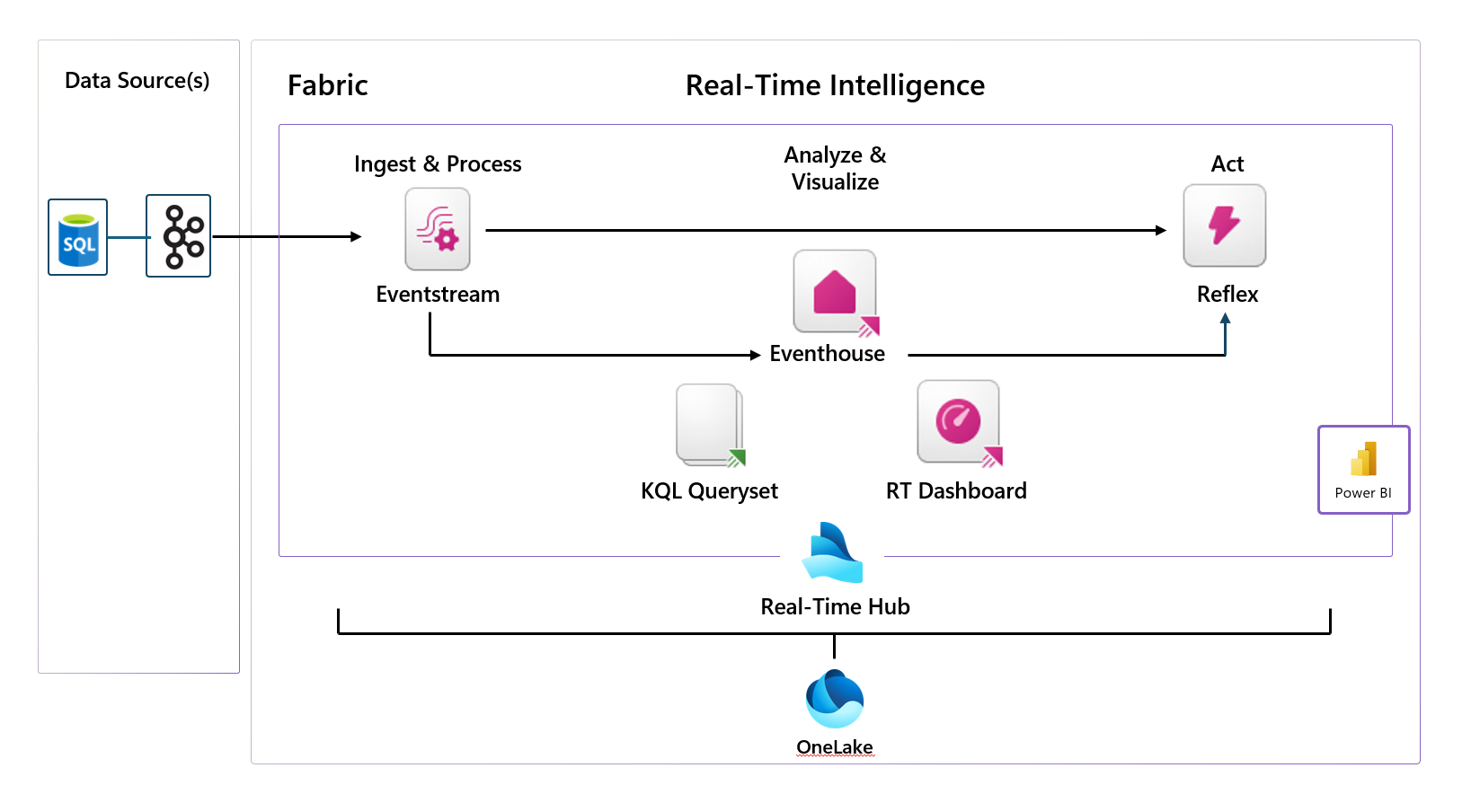About our client
Established in 1978, our client is an industrial technology company. With 2000+ patents for technological innovations, they provide integrated technology and software to the world’s largest industries. From purpose-built products to enterprise lifecycle solutions, they are transforming industries such as agriculture, construction, geospatial, and transportation.
The issue at hand
The client’s initial solution and how we stepped in
Diving into the new Fabric setup
In our project, we implemented a comprehensive real-time intelligence solution using Microsoft Fabric's capabilities. This setup enabled seamless data ingestion, processing, and analysis, providing immediate insights and automated responses to data anomalies. Here are the detailed steps of our implementation:
Eventstream
- Ingestion and processing
· We
used Eventstreams within Microsoft Fabric RTI to ingest data from Azure SQL
database into Fabric.
· The
ERP system data stored in Azure SQL database was captured using the Azure SQL
Database CDC source connector. This provided snapshots of the current data.
· Kafka
was employed to stream this ERP data into the system.
· Eventstreams
efficiently converted data from JSON into a table. This addressed Kafka
metadata issues to ensure seamless data integration.
Eventhouse
- Storage and processing
· Once
ingested, the data was transferred to Eventhouse, which managed high-velocity
data streams.
· Eventhouse
ensured secure and efficient access and processing of the stored data. This
allowed a high level of performance and reliability to be maintained.
· This
setup managed large volumes of streaming data, supporting our real-time
analytics requirements.
KQL
Queryset - Data management and transformation
· KQL
Queryset managed the data by applying policies for transformations. This ensured
data integrity and consistency was maintained.
· We
used scheduled pipelines within KQL Queryset to regularly clean up tables. This
allowed data to remain accurate and up-to-date.
· KQL
was used to process and transform data stored in Eventhouse. With it, easy query
execution and results customization was enabled.
RT
Dashboard - Real-time analytics and visualization
· For
real-time analytics and visualization, the RT Dashboard using Power BI was
used. This is a component of the Real-Time Intelligence feature in Fabric.
· The
dashboard allowed us to monitor, visualize, and analyze data in real time. Immediate
insights were provided through various widgets and visualization tools.
· We
built reports on the RT Dashboard to monitor ERP metrics such as inventory
levels, order fulfillment, cash flow, and supplier performance in real time.
Reflex - Monitoring
and action
· Reflex
continuously monitored the data streams for defined conditions. It triggered
corresponding actions immediately upon detecting anomalies.
· This
setup ensured timely alerts and resolutions for any issues. It maintained the
smooth operation of the system and prevented potential disruptions.
· Reflex
played a crucial role in automating responses to data anomalies. The overall
efficiency and reliability of the real-time intelligence solution was improved.
OneLake
and Real-Time Hub - Centralized data management and access
· OneLake
served as a central repository for the ingested and processed data, providing a
unified storage solution.
· The
Real-Time Hub facilitated seamless integration and interaction between various
components of the system. It ensured efficient data flow and access.
Eventstream
- Ingestion and processing
· We
used Eventstreams within Microsoft Fabric RTI to ingest data from Azure SQL
database into Fabric.
· The
ERP system data stored in Azure SQL database was captured using the Azure SQL
Database CDC source connector. This provided snapshots of the current data.
· Kafka
was employed to stream this ERP data into the system.
· Eventstreams
efficiently converted data from JSON into a table. This addressed Kafka
metadata issues to ensure seamless data integration.
Eventhouse
- Storage and processing
· Once
ingested, the data was transferred to Eventhouse, which managed high-velocity
data streams.
· Eventhouse
ensured secure and efficient access and processing of the stored data. This
allowed a high level of performance and reliability to be maintained.
· This
setup managed large volumes of streaming data, supporting our real-time
analytics requirements.
KQL
Queryset - Data management and transformation
· KQL
Queryset managed the data by applying policies for transformations. This ensured
data integrity and consistency was maintained.
· We
used scheduled pipelines within KQL Queryset to regularly clean up tables. This
allowed data to remain accurate and up-to-date.
· KQL
was used to process and transform data stored in Eventhouse. With it, easy query
execution and results customization was enabled.
RT
Dashboard - Real-time analytics and visualization
· For
real-time analytics and visualization, the RT Dashboard using Power BI was
used. This is a component of the Real-Time Intelligence feature in Fabric.
· The
dashboard allowed us to monitor, visualize, and analyze data in real time. Immediate
insights were provided through various widgets and visualization tools.
· We
built reports on the RT Dashboard to monitor ERP metrics such as inventory
levels, order fulfillment, cash flow, and supplier performance in real time.
Reflex - Monitoring
and action
· Reflex
continuously monitored the data streams for defined conditions. It triggered
corresponding actions immediately upon detecting anomalies.
· This
setup ensured timely alerts and resolutions for any issues. It maintained the
smooth operation of the system and prevented potential disruptions.
· Reflex
played a crucial role in automating responses to data anomalies. The overall
efficiency and reliability of the real-time intelligence solution was improved.
OneLake
and Real-Time Hub - Centralized data management and access
· OneLake
served as a central repository for the ingested and processed data, providing a
unified storage solution.
· The Real-Time Hub facilitated seamless integration and interaction between various components of the system. It ensured efficient data flow and access.
 |
Figure 1: Components of Fabric’s Real-Time Intelligence
|

